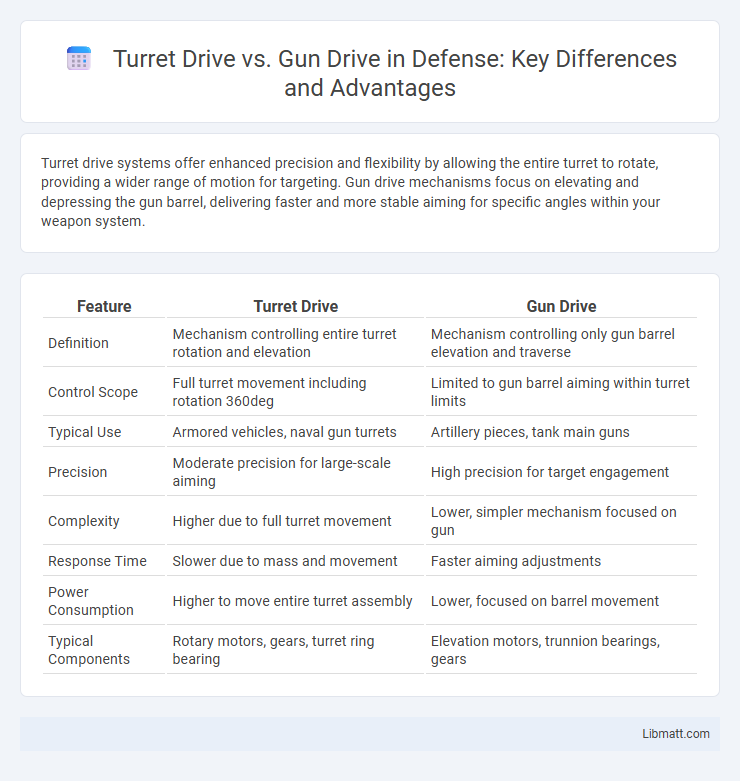Turret drive systems offer enhanced precision and flexibility by allowing the entire turret to rotate, providing a wider range of motion for targeting. Gun drive mechanisms focus on elevating and depressing the gun barrel, delivering faster and more stable aiming for specific angles within your weapon system.
Table of Comparison
| Feature | Turret Drive | Gun Drive |
|---|---|---|
| Definition | Mechanism controlling entire turret rotation and elevation | Mechanism controlling only gun barrel elevation and traverse |
| Control Scope | Full turret movement including rotation 360deg | Limited to gun barrel aiming within turret limits |
| Typical Use | Armored vehicles, naval gun turrets | Artillery pieces, tank main guns |
| Precision | Moderate precision for large-scale aiming | High precision for target engagement |
| Complexity | Higher due to full turret movement | Lower, simpler mechanism focused on gun |
| Response Time | Slower due to mass and movement | Faster aiming adjustments |
| Power Consumption | Higher to move entire turret assembly | Lower, focused on barrel movement |
| Typical Components | Rotary motors, gears, turret ring bearing | Elevation motors, trunnion bearings, gears |
Introduction to Turret and Gun Drives
Turret drives and gun drives serve critical roles in military and industrial applications by enabling controlled rotational and elevation movements. Turret drives specifically rotate weapon platforms or sensors horizontally, providing 360-degree coverage essential for targeting and surveillance, while gun drives primarily focus on elevating and depressing the barrel for precise firing angles. Both systems incorporate advanced servo motors and feedback mechanisms to enhance accuracy and responsiveness in dynamic operational environments.
Key Differences Between Turret Drive and Gun Drive
Turret drive systems offer 360-degree rotation with smooth, precise targeting essential for modern military applications, while gun drives typically provide more limited angular movement optimized for straightforward, linear firing sequences. Turret drives integrate advanced servo motors and feedback sensors for dynamic positioning and multi-axis stabilization, whereas gun drives rely on simpler mechanical linkages for rapid, repetitive firing motions. The key difference lies in turret drives' ability to support complex targeting and versatility compared to gun drives' focus on fixed, high-speed firing efficiency.
The Role of Turret Drive in Modern Armored Vehicles
Turret drive systems in modern armored vehicles provide precise rotational control essential for targeting accuracy and rapid weapon alignment under combat conditions. These drives integrate advanced hydraulic or electric motors to enable smooth, reliable turret movement, enhancing the vehicle's operational effectiveness. Compared to gun drive mechanisms, turret drives offer superior flexibility by supporting multi-axis rotation and stabilization for various weapon systems mounted on the turret.
Functionality and Mechanics of Gun Drive Systems
Gun drive systems utilize precision gearing and motor mechanisms to enable controlled elevation and traverse of the firearm, ensuring accurate target acquisition and firing stability. These systems typically integrate electric or hydraulic actuators that convert input power into smooth, incremental movements, optimizing responsiveness and reducing recoil impact. Compared to turret drives, gun drives emphasize fine-tuned adjustments of the gun barrel independently, allowing for enhanced precision and faster reaction to targeting commands.
Performance Comparison: Accuracy and Responsiveness
Turret drives offer superior accuracy due to their precise motor control and reduced backlash, enabling finer aiming adjustments critical in dynamic combat scenarios. Gun drives prioritize responsiveness, delivering rapid elevation and depression movements to quickly adapt to target changes, often at the cost of some positional precision. Your choice depends on whether pinpoint accuracy or swift reaction time holds more importance in your operational context.
Power Sources: Electric vs. Hydraulic Drives
Electric turret drives offer precise control, higher efficiency, and faster response times, making them ideal for applications requiring accuracy and energy savings. Hydraulic gun drives provide powerful torque and smooth operation, especially suited for heavy-duty or high-load scenarios where robust force is essential. Choosing your drive depends on balancing the need for control precision and power output based on your specific application requirements.
Maintenance and Reliability Factors
Turret drives require regular lubrication and precise alignment to maintain smooth operation, making maintenance more complex compared to gun drives, which often have simpler mechanical structures. The reliability of turret drives depends heavily on the integrity of multiple moving components, increasing the likelihood of wear and failure under heavy use, whereas gun drives tend to be more robust with fewer failure points. Effective maintenance schedules and high-quality parts are crucial for ensuring long-term reliability in both turret and gun drive systems.
Cost Implications: Manufacturing and Upgrades
Turret drive systems typically have higher initial manufacturing costs due to their complex gearing and motor requirements, whereas gun drive mechanisms tend to be simpler and more cost-effective to produce. Upgrading turret drives often involves significant expenses related to precision components and integration with fire control systems, while gun drives benefit from more straightforward modifications and lower upgrade costs. Your choice between the two should consider long-term operational costs alongside initial manufacturing investments.
Future Trends in Turret and Gun Drive Technology
Future trends in turret and gun drive technology emphasize increased automation, precision, and integration of AI-driven control systems to enhance targeting accuracy and response speed. Advancements in electric and hybrid drives are improving energy efficiency and reducing maintenance requirements, while modular designs facilitate rapid upgrades and customization for diverse combat scenarios. Your defense systems will benefit from these innovations through enhanced operational flexibility and reduced lifecycle costs.
Choosing the Right System: Tactical and Operational Considerations
Selecting between turret drive and gun drive systems depends on tactical requirements such as precision, speed, and versatility in target engagement. Turret drives offer enhanced rotational movement and faster aiming capabilities, ideal for dynamic combat scenarios requiring rapid target reacquisition. Gun drives provide simpler mechanics with potentially higher recoil management, suitable for operations prioritizing stability and sustained fire accuracy.
Turret drive vs Gun drive Infographic

 libmatt.com
libmatt.com